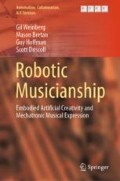Abstract
One of the main principle guidelines for our Robotic Musicianship research is to develop robots that can “listen like a human and play like a machine.” We would like our robots to be able to understand music as humans so they can connect with their co-players (“listen like a human”) but also surprise and inspire humans with novel music ideas and capabilities (“play like a machine”).
Access this chapter
Tax calculation will be finalised at checkout
Purchases are for personal use only
Notes
References
Puckette, Miller S., Miller S. Puckette Ucsd, Theodore Apel, et al. 1998. Real-time audio analysis tools for pd and msp.
Scheirer, Eric D. 1998. Tempo and beat analysis of acoustic musical signals. The Journal of the Acoustical Society of America, 103 (1): 588–601
Desain, Peter, H.J. Honing, et al. 2002. Rhythmic stability as explanation of category size. In Proceedings of the international conference on music perception and cognition, pages CD–rom. Sydney: UNSW
Tanguiane, Andranick S. 1993. Artificial perception and music recognition. Springer
Fred, Lerdahl. 2001. Tonal pitch space.
Eugene, Narmour. 1992. The analysis and cognition of melodic complexity: The implication-realization model. University of Chicago Press.
Elizabeth Hellmuth Margulis. 2005. A model of melodic expectation. Music Perception: An Interdisciplinary Journal 22 (4): 663–714.
Nattiez, Jean-Jacques. 1997. What is the pertinence of the Lerdahl-jackendoff theory? In Perception and cognition of music, 413–419.
Farbood, Morwaread Mary. 2006. A quantitative, parametric model of musical tension. PhD thesis, Massachusetts Institute of Technology.
Lerdahl, Fred, and Carol L. Krumhansl. 2007. Modeling tonal tension. Music Perception: An Interdisciplinary Journal 24 (4): 329–366.
Justus, Timothy C., and Jamshed J. Bharucha. 2001. Modularity in musical processing: The automaticity of harmonic priming. Journal of Experimental Psychology: Human Perception and Performance 27 (4): 1000.
Steinbeis, Nikolaus, Stefan Koelsch, and John A. Sloboda. 2006. The role of harmonic expectancy violations in musical emotions: Evidence from subjective, physiological, and neural responses. Journal of Cognitive Neuroscience 18 (8): 1380–1393.
von Helmholtz, H. 1954. On the sensations of tone (A.J. Ellis, trans.). Braunschweig: Vieweg & Son. (Original work published 1863).
Plomp, Reinier. 1964. Rate of decay of auditory sensation. The Journal of the Acoustical Society of America 36 (2): 277–282.
Hutchinson, William, and Leon Knopoff. 1978. The acoustic component of western consonance. Journal of New Music Research 7 (1): 1–29.
Vassilakis, Pantelis N., and K. Fitz. 2007. Sra: A web-based research tool for spectral and roughness analysis of sound signals. In Proceedings of the 4th sound and music computing (SMC) conference, 319–325.
Simon, Ian, Dan Morris, and Sumit Basu. 2008. Mysong: Automatic accompaniment generation for vocal melodies. In Proceedings of the SIGCHI conference on human factors in computing systems, 725–734. ACM
Abadi, Martín, Ashish Agarwal, Paul Barham, Eugene Brevdo, Zhifeng Chen, Craig Citro, Greg S Corrado, Andy Davis, Jeffrey Dean, Matthieu Devin, et al. 2016. Tensorflow: Large-scale machine learning on heterogeneous distributed systems. arXiv:1603.04467.
Zen, Heiga, Keiichi Tokuda, and Alan W. Black. 2009. Statistical parametric speech synthesis. Speech Communication 51 (11): 1039–1064.
van den Oord, Aäron, Nal Kalchbrenner, Oriol Vinyals, Lasse Espeholt, Alex Graves, and Koray Kavukcuoglu. 2016. Conditional image generation with pixelCNN decoders. arXiv:1606.05328.
Alexander, Lerch. 2012. An introduction to audio content analysis: Applications in signal processing and music informatics. Wiley.
Puckette, Miller, et al. 1996. Pure data: Another integrated computer music environment. In Proceedings of the second intercollege computer music concerts, 37–41.
Eden, Davies. 2007. Beyond dance: Laban’s legacy of movement analysis. Routledge
Martin Bland, J., and Douglas G. Altman. 1997. Statistics notes: Cronbach’s alpha. BMJ 314 (7080): 572.
Author information
Authors and Affiliations
Corresponding author
Rights and permissions
Copyright information
© 2020 Springer Nature Switzerland AG
About this chapter
Cite this chapter
Weinberg, G., Bretan, M., Hoffman, G., Driscoll, S. (2020). “Listen Like A Human”—Human-Informed Music Perception Models. In: Robotic Musicianship. Automation, Collaboration, & E-Services, vol 8. Springer, Cham. https://doi.org/10.1007/978-3-030-38930-7_3
Download citation
DOI: https://doi.org/10.1007/978-3-030-38930-7_3
Published:
Publisher Name: Springer, Cham
Print ISBN: 978-3-030-38929-1
Online ISBN: 978-3-030-38930-7
eBook Packages: EngineeringEngineering (R0)

